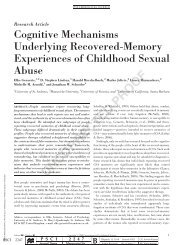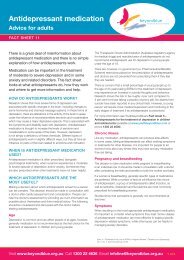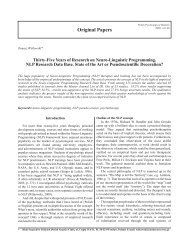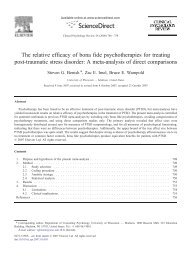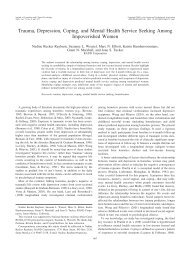Complex post-traumatic stress disorder - Wikipedia, the free ...
Complex post-traumatic stress disorder - Wikipedia, the free ...
Complex post-traumatic stress disorder - Wikipedia, the free ...
Create successful ePaper yourself
Turn your PDF publications into a flip-book with our unique Google optimized e-Paper software.
2/02/2011 <strong>Complex</strong> <strong>post</strong>-<strong>traumatic</strong> <strong>stress</strong> disorde…<br />
parents with this condition and <strong>the</strong>ir children do not receive appropriate treatment. [11][12]<br />
Differentiating Traumatic grief from C-PTSD<br />
Main articles: Grief and Grief counseling<br />
Traumatic grief [13][14][15][16] or complicated mourning [17] are conditions [18] where both trauma and grief<br />
coincide. If a <strong>traumatic</strong> event was only life threatening <strong>the</strong>n more likely <strong>the</strong> survivor will experience <strong>post</strong><strong>traumatic</strong><br />
<strong>stress</strong> symptoms. If <strong>the</strong> survivor was close to <strong>the</strong> person who died, <strong>the</strong>n more likely symptoms of grief<br />
will also develop. When <strong>the</strong> death is of a loved one and was sudden or violent <strong>the</strong>n both symptoms coincide.<br />
This is likely in children exposed to community violence. [19]<br />
For C-PTSD to manifest <strong>the</strong> violence would occur under conditions of captivity, loss of control and<br />
disempowerment, coinciding with <strong>the</strong> death of a friend or loved one in life threatening circumstances. This again<br />
is most likely for children and stepchildren who experience prolonged domestic or chronic community violence<br />
that ultimately results in <strong>the</strong> death of friends and loved ones. The phenomena of <strong>the</strong> increased risk of violence<br />
and death of stepchildren is referred to as <strong>the</strong> Cinderella effect.<br />
There are conceptual links between trauma and bereavement since loss of a loved one is inherently <strong>traumatic</strong>. [20]<br />
Attachment <strong>the</strong>ory, BPD and C-PTSD<br />
Main articles: Attachment <strong>the</strong>ory and Borderline personality <strong>disorder</strong><br />
See also: Attachment in adults, Attachment in children, Attachment <strong>disorder</strong>, Attachment-based<br />
psycho<strong>the</strong>rapy, Cinderella effect, Self-injury, and Emotionally focused <strong>the</strong>rapy<br />
This controversial area [21] underlines <strong>the</strong> fragility of C-PTSD as an empirical diagnostic category separate from<br />
PTSD. [22][23]<br />
C-PTSD may have originated from observations of acute breakthrough of borderline personality (BPD)<br />
symptoms in trauma victims. [citation needed] This could be diagnosed as PTSD with borderline features, where<br />
<strong>the</strong> symptoms of BPD were not sufficient to sustain a (hypo<strong>the</strong>tical) dual diagnosis of BPD and PTSD. C-PTSD<br />
may share some symptoms with both PTSD and BPD. [24] Judith Herman has suggested that C-PTSD be used<br />
in place of borderline. [25]<br />
It may help to understand <strong>the</strong> intersection of attachment <strong>the</strong>ory with C-PTSD and BPD if one reads <strong>the</strong><br />
following opinion of Bessel A. van der Kolk toge<strong>the</strong>r with an understanding drawn from a description of BPD:<br />
Uncontrollable disruptions or distortions of attachment bonds precede <strong>the</strong> development of <strong>post</strong><strong>traumatic</strong><br />
<strong>stress</strong> syndromes. People seek increased attachment in <strong>the</strong> face of danger. Adults, as<br />
well as children, may develop strong emotional ties with people who intermittently harass, beat,<br />
and, threaten <strong>the</strong>m. The persistence of <strong>the</strong>se attachment bonds leads to confusion of pain and love.<br />
Trauma can be repeated on behavioural, emotional, physiologic, and neuroendocrinologic levels.<br />
Repetition on <strong>the</strong>se different levels causes a large variety of individual and social suffering. Anger<br />
directed against <strong>the</strong> self or o<strong>the</strong>rs is always a central problem in <strong>the</strong> lives of people who have been<br />
violated and this is itself a repetitive re-enactment of real events from <strong>the</strong> past. Compulsive<br />
repetition of <strong>the</strong> trauma usually is an unconscious process that, although it may provide a temporary<br />
sense of mastery or even pleasure, ultimately perpetuates chronic feelings of helplessness and a<br />
subjective sense of being bad and out of control. Gaining control over one's current life, ra<strong>the</strong>r than<br />
repeating trauma in action, mood, or somatic states, is <strong>the</strong> goal of healing. [26][27]<br />
…wikipedia.org/…/<strong>Complex</strong>_<strong>post</strong>-trau… 2/8



